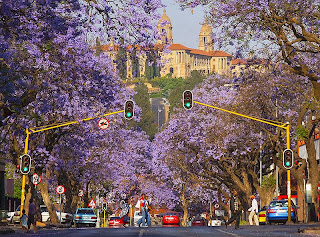Some background to the Jacarandas of Pretoria
October
heralds the blooming of the jacarandas in Pretoria and hundreds of tourists can
be seen photographing this spectacle in Arcadia, The small suburb of Pretoria where we live. Credit for
this belongs to JD Celliers who imported two jacaranda trees, Jacaranda
Mimosifolio, from Rio de Janeiro in 1888.
He planted them in the front garden of his home Myrtle Lodge in Sunnyside, now part of Sunnyside Primary School at 146 Celliers Street. These trees are still standing and bear a bronze plaque and can be viewed during school hours.
In
1898, James Clark, a keen horticulturist obtained a contract from the
government to plant hundreds of jacarandas throughout the city. The trees did
so well that he was charged with the task of lining all the major streets of
Pretoria with jacarandas. Government Avenue is unique with its double row of
jacarandas on either side. It is the only street in Pretoria with a double row.
They were planted like this to provide complete shade for the government
officials walking to the Union Buildings from Bryntirion Estate.
 While
the rest of Pretoria goes mauve in October, Herbert Baker Street in the suburb
of Groenkloof goes white, but also with jacarandas. The white species was introduced
in 1962 by a resident
by the name of H. Bruinslich and were imported from Peru.
While
the rest of Pretoria goes mauve in October, Herbert Baker Street in the suburb
of Groenkloof goes white, but also with jacarandas. The white species was introduced
in 1962 by a resident
by the name of H. Bruinslich and were imported from Peru.



No comments:
Post a Comment